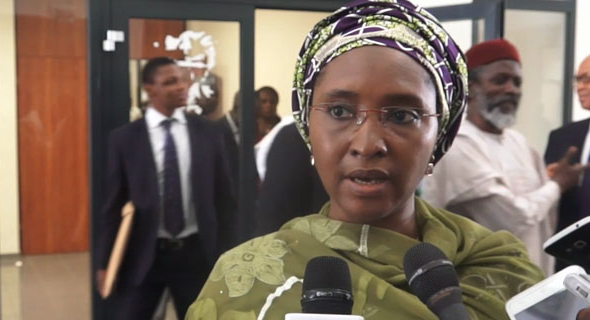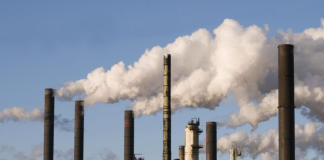- Defence, education, police lead in sectoral allocations
- Crude price slumps below $60 over US, China trade deal
The Minister of Finance, Budget and National Planning, Mrs. Zainab Ahmed, has said the federal government adopted a lower oil benchmark price of $57 per barrel for the 2020 budget as against the $60 per barrel in the 2019 budget because of the expected oil glut in 2020, as well as the need to cushion against unexpected price shock.
Ahmed, at a budget breakdown yesterday in Abuja, said there were strong indications of an oversupplied oil market in 2020, adding that all three of the major forecasters – including the Organisation of the Petroleum Exporting Countries (OPEC), International Energy Association (IEA) and the US Energy Information Administration (EIA) had predicted non-OPEC production growing by about two million barrels per day (mbpd) in 2019 and by more next year.
She also listed the Ministry of Defence as having the largest share of recurrent expenditure in the 2020 budget with a total allocation of N778.59 billion, followed by the Ministry of Education with N490.20 billion, Police Affairs with N395.83 billion, Health with N336.32 billion and Interior with N219.46 billion.
She spoke on the day oil prices fell more than two per cent as scant details about the first phase of a trade deal between the United States and China undercut optimism over continued tension between the two countries that had helped lift crude markets by three per cent at the end of last week.
According to the minister, the US shale oil accounts for most of the total supply increase, adding also that new projects in Norway, Brazil and Australia will also contribute to the increase in non-OPEC supply.
She said market sentiments did not support an expansion in demand, adding that growth in demand for OPEC oil and condensates specifically were projected to slow down next year.
Ahmed added that oil production volume is projected to average 2.18 million barrels per day for 2020, even lower than the projected oil production volume of 2.3mbpd for 2019.
“We believe that this is a more realistic projection. For 2021 and 2022, the projections are 2.22mbpd and 2.36mbpd respectively. Actual daily crude oil production and exports have been below budget projections since 2013, despite installed capacity of up to 2.5mbpd, for a number of reasons.
“For 2018, actual production was 1.84mbpd and for the first half of 2019 it was 1.86mbpd (base production).”
On the key assumptions of the 2020 budget framework, the minister said the real GDP growth projections are 2.93 per cent, 3.35 per cent and 3.85 per cent for 2020, 2021 and 2022, respectively.
She said even though this fell short of the ERGP projection, the trajectory remained in the right direction.
According to her, personnel cost (inclusive of pension costs) was estimated at over N3 trillion.
She, however, noted that the federal government was taking steps to contain the rising personnel costs, particularly the new directive to withhold salaries of individuals and institutions not enrolled into the IPPIS scheme.
Ahmed stated that aggregate revenue available to fund the 2020 budget is projected at N8.155 trillion, representing seven per cent or N561.2 billion more than the 2019 budget of N7.59 trillion.
She said in order to promote fiscal transparency, accountability and comprehensiveness, the budget of 10 major GOEs (government-owned enterprises) are integrated in the 2020 budget.
She said in aggregate, 43.86 per cent of projected revenues would come from oil sources, while the balance is to be earned from non-oil sources.
The minister also said the overall size of the budget had been constrained by relatively low revenues.
She noted that of the N10.33 trillion budget for next year, recurrent (non-debt) spending is expected to total N4.88 trillion, reflecting increases in salaries and pensions, including the provisions for implementation of the new minimum wage.
According to her, capital expenditure, inclusive of transfers, GOEs capital and project-tied loans as percentage of federal government expenditure is 24 per cent.
Ahmed also said the N2.45 trillion set aside for debt service is 23.74 per cent of target expenditure, adding that the provision to retire maturing bond to local contractors increased by 169.09 per cent from N110 billion in FY2019 to N296 billion.
Among other things, she said the overall budget deficit of N2.175 trillion in 2020 represented 1.52 per cent of GDP.
She said projected deficit was still within threshold stipulated in the Fiscal Responsibility Act (FRA) 2007, stressing that the budget deficit is to be financed mainly by borrowing N1.649 trillion, consisting of domestic sources at N744.99 billion and foreign sources of N850 billion, which will indicate a gradual shift from commercial to more concessionary financing.
Ahmed also said some projects were captured in the MTEF but not in the 2020 budget as laid in the National Assembly by the president.
These include the N61 billion allocation to the presidential power initiative, federally funded projects in the oil and gas sector to be implemented by the NNPC totalling N1. 22 trillion, as well as the N272 billion transfers to the Tertiary Education Trust Fund (TETFUND) for infrastructure projects in tertiary institutions- including the N82.35 billion transfer to Nigeria Sovereign Wealth Investment Authority (NSIA) for Public Private Partnership (PPP)/ Presidential Infrastructure Development Fund (PIDF).
However, the Ministry of Defence has the largest share of recurrent expenditure with total allocation of N778.59 billion, followed by the Ministry of Education with N490.20 billion. Others are police affairs with N395.83 billion, health N336.32 billion and Interior with N219.46 billion.
For capital expenditure, the ministry of works and housing got the lion’s share of N259.20 billion, followed by Ministry of Education with N162.74 billion while the Ministry of Power got N127.67 billion as well as transport with N123.07 billion. The ministry of defence got N99.87 billion among others.
Oil Price Slumps Below $60 over US, China Trade Deal
Meanwhile, oil prices fell more than two per cent yesterday as scant details about the first phase of a trade deal between the United States and China undercut optimism over continued tension between the two countries that had helped lift crude markets by three per cent at the end of last week.
While the global benchmark crude, Brent, dropped $1.52 to $58.99 a barrel, the US West Texas Intermediate (WTI) crude lost $1.45 to $53.25 a barrel.
Late on Friday, the United States and China outlined the first stage of a trade deal and suspended this week’s scheduled US tariff hikes. But existing tariffs remain in place and officials on both sides said much more work was needed before an accord could be agreed.
Brent and WTI rose more than three per cent last week, their first weekly increase in three weeks.
Reuters reported that there are also worries that further escalation along the Syrian and Turkish border could affect output or exports from Iraq, providing more support for oil prices.
Syrian troops entered a northeastern town yesterday. The Saudi Arabia’s Energy Minister, Prince Abdulaziz bin Salman, said oil exporters taking part in a global output deal between OPEC and its allies, a grouping known as OPEC+, were showing serious commitment to the cuts.
Russian Energy Minister Alexander Novak said there were no talks underway to change the OPEC+ deal.
Kuwait’s Oil Minister, Khaled al-Fadhel said it was too early to discuss a possible build-up in oil inventories in 2020.
Khaled al-Fadhel said a price range of $50-$70 per barrel would be acceptable.
The compliance of OPEC+ producers with the supply-reduction agreement was seen at above 200 per cent in September, sources familiar with the matter said yesterday.
China showed strong demand for oil, with its September imports rising 10.8 per cent from a year earlier as refiners ramped up output amid stable profit margins and solid demand for fuel.
Source: THISDAY














